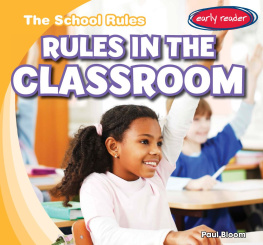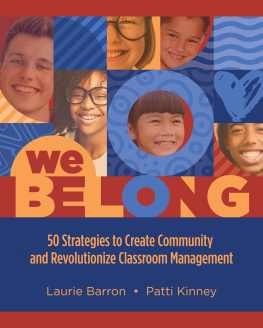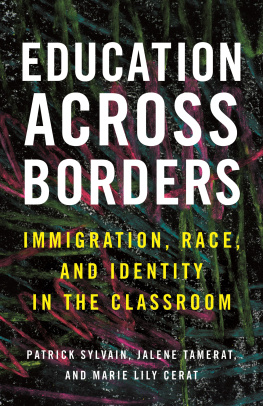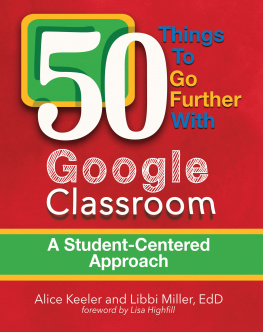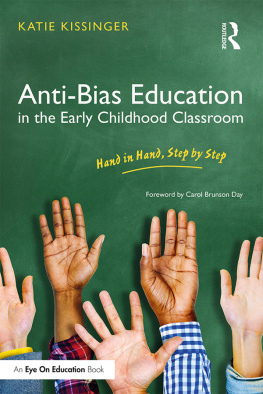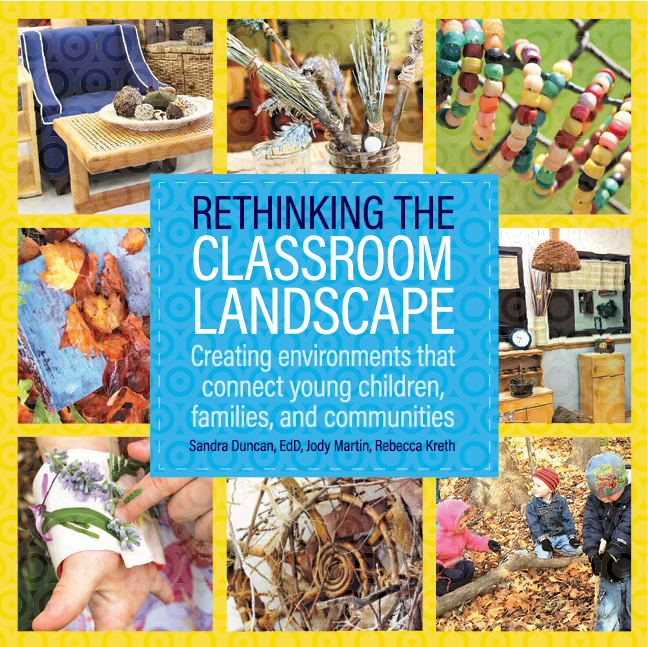Contents
Rethinking the
Classroom
Landscape
Creating Environments That
Connect Young Children,
Families, and Communities
Sandra Duncan, EdD, Jody Martin, and Rebecca Kreth

Copyright 2016 Sandra Duncan, Jody Martin, Rebecca Kreth
Published by Gryphon House, Inc.
P. O. Box 10, Lewisville, NC 27023
800.638.0928; 877.638.7576 (fax)
Visit us on the web at www.gryphonhouse.com.
All rights reserved. No part of this publication may be reproduced or transmitted in any form or by any means, electronic or technical, including photocopy, recording, or any information storage or retrieval system, without prior written permission of the publisher.
Printed in the United States. Every effort has been made to locate copyright and permission information.
Photographs on pages 10, 29, 38, 39, 53, 59, 63, 86, 96, 108, 109, 114, 118, 125, 138, 141, 143, 152, 154, 156, 159, 160, 163, 171, 177, 204, 208, 211, 213, 215, 222, 224, and 230 used under license from Shutterstock.com.
Other photographs courtesy of the authors.
Bulk Purchase
Gryphon House books are available for special premiums and sales promotions as well as for fund-raising use. Special editions or book excerpts also can be created to specifications. For details, call 800.638.0928.
Disclaimer
Gryphon House, Inc., cannot be held responsible for damage, mishap, or injury incurred during the use of or because of activities in this book. Appropriate and reasonable caution and adult supervision of children involved in activities and corresponding to the age and capability of each child involved are recommended at all times. Do not leave children unattended at any time. When making choices about allowing children to touch or eat certain foods, plants, or flowers, make sure to investigate possible toxicity and consider any food allergies or sensitivities. Observe safety and caution at all times.
Library of Congress Cataloging-in-Publication Data
The Cataloging-in-Publication Data is registered with the Library of Congress for ISBN 978-0-87659-563-3.
Acknowledgments
We want to extend our deepest appreciation and gratitude to those who shared knowledge, insight, and inspiration for this book: children and teachers in the exemplary classrooms, centers, and schools represented, early childhood advocates who graciously shared their personal stories, early childhood companies that provided images and ideas about naturally inspired products, college students who offered fresh innovative thinking, and colleagues who guided us with their wisdom. And finally, to our friends and families, we thank you for supporting, encouraging, and giving us the time and latitude to write this book. For all, we are deeply grateful.
Sue Penix Downtown Baltimore Child Care Dr. Pradnya Patet Mountain Road Preschool Dana Wiser TalTree Arboretum Danielle Monroy Liana Chavarin Nature Explore Dr. Ruth Wilson Natural Pod Rhonda Johnson Nancy Rosenow Pressman Academy Early Childhood Center Rachel Larimore Creative Care for Children Nancy Manewith Early Learning Childrens Community Gail Szautner Piper Center for Family Studies at Baylor University Life Without Plastic Celeste Joyner Carri McGuire Chippewa Nature Centers Nature Preschool Crystal Sanders Mickey MacGillivray Early Learning Childrens Community Kay Koern Vyvyan Carver Creative Child Care Center Steve Erwin Danielle Werchuk College of the Canyons Early Childhood Center Nancy Alexander County Child Care Dawn McCloud Bellaboos Childrens Play and Discovery Center Milestones Early Childhood Development Center Happy Faces II Academy Lisa Krueger Alexander Graham Bell Montessori School John Rosenow Child Development and Learning Laboratory Amarie Merasty Opportunity School Dr. Gerald Newmark Coyote Trails School of Nature The Childrens Project Dimensions Education Program Just for You Glenn Smith Childrens Choice Louise Mass Mykaela Haarstad Christa Winters Kimberly Greene Epps Ganero Child Development Center at Pierce College Margo Sipes Eric Strickland Board of Jewish Early Education Center at Bnai Tikvah Sydney Roach City Neighbors Sherry Trebus Courtney Gardner Hopes Home Janet Sear Place of our Own Childrens Home + Aid Milgard Child Development Center at Pierce College Lakisha Reid Mountain Road Preschool Tammy Lockwood Talkeetna Child Development Center Cindi Catlin Gaskins Gretchen House Cookie Cummings The Nature Preschool at Irvine Nature Center Sharyl Robin Community Playthings Margaret Desmores The Childrens College Childrens Discovery Museum Corinne Lagoy Monica Wiedel-Lubinski The Adventure Club Chief Leschi Schools Preschool Programs Nancy W. Darden Child Development Center at East Carolina University Kathy Walker Discovery Early Learning Center Jeremy South Steilacoom Family Center Katie Gilstad Rebecca Stoessner Growing Minds Learning Center Julie Fowler Natures Way Preschool Jacquelyn Weller Winnetka Public Schools Marcus Collins Barbara McVicker The Saul Spielberg Early Childhood Center Corrine Tollett-Carr Region 16 Head Start Monica Walker Erin Austria Care for Tots Learning Center Jay Sinha United States Air Force Child Development Centers Heather Parker Lynn Hummel Roslyn Outdoor School Dr. Debarati Majumdar Narayan Treezles Paula Barnes Board of Jewish Education Early Childhood Centers at Beth Hillel Special Blessings Child Care City Neighbors Hamilton Bridgitte Alomes Peifer Elementary School Sue Noble Valerie Caswell Denika Hucks CASA Child Care Berkeley Forest School Mari Potter Little Explorers University Presbyterian Childrens Center Daniel Robert Midland Childrens Discovery Museum Rae Pica Creative Care for Children Forest Ridge Academy Community Play School
Preface
Children are miracles. Believing that every child is a miracle can transform the way we design for childrens care. When we invite a miracle into our lives we prepare ourselves and the environment around us.... We make it our job to create, with reverence and gratitude, a space that is worthy of a miracle!
Anita Rui Olds, Child Care Design Guide
Is your space worthy? If we blindfolded you, took you on a plane, and dropped you in the middle of an early childhood classroom, would you know where you are based on what you see? Our premise is the answer would be no because most classrooms look the same. The majority of materials and equipment now found in most early childhood classrooms are specified and manufactured for early childhood environments. The result: cookie-cutter classrooms.
Rethinking the Classroom Landscape encourages teachers of young children to transform ordinary spaces into reflective and meaningful landscapes. With easy-to-implement ideas and strategies based on five guideposts, this book supports and encourages educators to create early childhood environments that vividly connect to children, adults, and their communities. We believe in the importance of neighborhood and communities, the connection between past and present with the people who live in these communities, and the influence of geography, topography, flora, and fauna. We believe that early childhood environments should be not just the actual spaces and objects within these spaces, but also a reflection of the geographical, cultural, historical, and environmental forces shaping these spaces. We believe in the important distinction between space and place.


